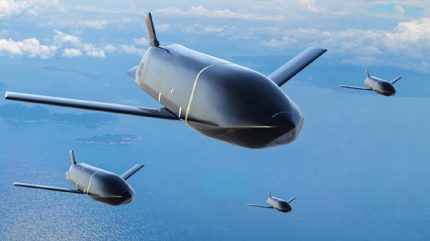
Togther, the US Navy and Lockheed Martin have successfully conducted the simultaneous flight test of four integrated Long Range Anti-Ship Missiles (LRASMs).
During the 12th Integrated Test Event (ITE-12), the US Navy was able to demonstrate the weapon’s lethality from mission planning through kill chain integration and its effects on the target.

Discover B2B Marketing That Performs
Combine business intelligence and editorial excellence to reach engaged professionals across 36 leading media platforms.
All mission objectives are said to be met, “reinforcing high confidence in the weapon’s capabilities and superior firepower,” according to the US defence prime.
LRASM is an autonomous, precision-guided anti-ship stand-off missile. It was developed by Lockheed Martin in collaboration with the US Defense Advanced Research Project Agency (DARPA) and Office of Naval Research (ONR).
It first achieved early operating capability in 2018 on the B-1B Lancer long-range strategic bomber, and on the F/A-18E/F in 2019. However, LRASM is also designed to be launched by Mark 41 Vertical Launch Systems aboard most US Navy vessels and fixed wing aircraft.
It can be fired from outside direct counter-fire ranges with maximum possibility of target hit. The missile can fulfil Navy needs as an anti-surface warfare weapon capability. The LRASM is designed to carry a 1,000lb penetrating blast fragmentation warhead.

US Tariffs are shifting - will you react or anticipate?
Don’t let policy changes catch you off guard. Stay proactive with real-time data and expert analysis.
By GlobalDataThe weapon also reduces dependency on intelligence, surveillance and reconnaissance (ISR) platforms, network links, and GPS navigation in electronic warfare environments. Semi-autonomous guidance algorithms will allow it to use less-precise target cueing data to pinpoint specific targets in the contested domain.
The self-directed sensing, advanced signature control and dynamic response features allow the missile to approach targets, while defeating air defence systems.
Integrated network test
“We have continued to invest in the design and development of LRASM’s anti-surface warfare capabilities to ensure that warfighters have the 21st century security solutions they need to complete their missions and come home safely,” said Lisbeth Vogelpohl, LRASM program director at Lockheed Martin Missiles and Fire Control.
ITE-12 was the next ‘big-step’ in LRASM’s evolution. The successful test was a graduation exercise for the missiles’ latest configuration and lays the foundation for increased capabilities to come.
Through new software and algorithms missiles can begin to act within a swarm network. While this is currently more common with uncrewed systems – often in the air, but Ukraine has also demonstrated their asymmetric advantage in the Black Sea – the LRASM will provide a competitive edge to the naval domain.





